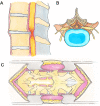Decompression Using Minimally Invasive Surgery for Lumbar Spinal Stenosis Associated with Degenerative Spondylolisthesis: A Review
- PMID: 34322837
- PMCID: PMC8586290
- DOI: 10.1007/s40122-021-00293-6
Decompression Using Minimally Invasive Surgery for Lumbar Spinal Stenosis Associated with Degenerative Spondylolisthesis: A Review
Abstract
Lumbar spinal stenosis (LSS), which often occurs concurrently with degenerative spondylolisthesis (DS), is a common disease in the elderly population, affecting the quality of life of aged people significantly. Notwithstanding the frequently good effect of conservative therapy on LSS, a minority of the patients ultimately require surgery. Surgery for LSS aims to decompress the narrowed spinal canals with preservation of spinal stability. Traditional open surgery, either pure decompression or decompression with fusion, was considered effective for the treatment of LSS with or without DS. However, the long-term clinical outcomes of traditional open surgery are still unclear. Moreover, the disadvantages of conventional open surgery are extensive, examples including tissue injuries or secondary instability, with limited outcomes and significant reoperation rates. With the development and improvement of surgical tools, various minimally invasive spine surgery (MISS) methods, including indirect decompression techniques of interspinous process devices (IPDs) and direct decompression techniques such as microscopic spine surgery or endoscopic spine surgery (ESS), have been updated with enhancement. IPDs, such as Superion devices, were reported to behave with comparable physical function, disability, and symptoms outcomes to laminectomy decompression. As an emerging technique of MISS, ESS has beneficial hallmarks including minimal tissue injuries, reduced complication rates, and shortened recovery periods, thus gaining popularity in recent years. ESS can be classified in terms of endoscopic hallmarks and approaches. Predictably, with the continuous development and gradual maturity, MISS is expected to replace traditional open surgery widely in the surgical treatment of LSS associated with DS in the future.
Keywords: Decompression; Degenerative spondylolisthesis; Endoscopic spine surgery; Interspinous process devices; Lumbar spinal stenosis; Lumbar spine; Minimally invasive spine surgery.
© 2021. The Author(s).
Figures





References
Publication types
LinkOut - more resources
Full Text Sources
Research Materials

